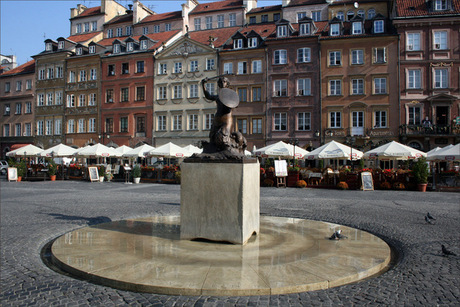Warsaw’s Mermaid
The best-known legend, by Artur Oppman, is that long ago two of Triton's daughters set out on a journey through the depths of the oceans and seas. One of them decided to stay on the coast of Denmark and can be seen sitting at the entrance to the port of Copenhagen (the little mermaid.) The second mermaid reached the mouth of the Vistula River and plunged into its waters. At the foot of today's Old Town, she left the water to rest on the sandy shore, and she so liked the place that she decided to stay. Soon the fishermen noticed that during their fishing someone was churning the waves of the Vistula, tangling the nets and releasing the fish. But the mermaid enchanted them with her beautiful singing, and they did not harm her. One day a wealthy merchant saw the mermaid and her lovely song. He quickly calculated how much money he could make if he captured the mermaid and displayed her at market fairs. He tricked the mermaid, seized her and imprisoned her in a wooden shed without any water. A young farmhand heard the mermaid's cries, and with the help of friends he freed her at night. Grateful that the townspeople had defended her, the mermaid promised that she would help them in time of need. This is why the Warsaw Mermaid is armed: She bears a sword and a shield to defend the city.
Among the lesser-known legends is the one written by Maria Krüger entitled "The Noble Griffin and the Beautiful Mermaid." According to the legend, the security of the medieval city of Warsaw was guarded by a manly and noble Griffin. When he once took a journey with the river boatmen to the Baltic, he met a beautiful Mermaid. They fell deeply in love and the Mermaid swam with them back to Warsaw. From then on, they both watched over the townspeople. When the Swedes attacked Warsaw in the 17th century , the valiant Griffin was treacherously wounded by the enemy and shortly died, and his companion, the brave Mermaid, seized sword and shield and courageously fought in defense of the city. Grateful residents of the city on the Vistula were smitten with her and placed her image on the arms of their city.The Mermaid has been the coat of arms of Warsaw for centuries, which is rather unusual for a place that is situated about 300 km from the sea. Legend has it that there were two mermaid sisters who swam from the Atlantic into the Baltic Sea. The smaller one now sits on a rock at the entrance to the port of Copenhagen. The other swam to Gdansk and then up the Vistula River as far as the Warsaw Old Town. She loved the place and would sing to the local fishermen in her beautiful voice. One day, however, she was tricked and captured by a wealthy merchant, who planned to put her in a cage and show at fairs. Her cries for help were heard by some local people, who came to her rescue. In return, the mermaid offered to defend them in times of need. That is why the Warsaw Mermaid bears a sword and a shield. And she certainly needed them in the course of Warsaw's turbulent past.
The emblem can now be found on all the Warsaw trams, buses and taxis. In addition, there are two statues of the Mermaid here: the larger one on the Vistula near the Swietokrzyski Bridge and the other, smaller one - now in the centre of the Old Town Square. The latter is a zinc cast of the sculpture by Konstanty Hegel, created in 1855. The statue on the Vistula, on the other hand, dates back to 1939. Its author Ludwika Krasowska-Nitschova modelled its face on that of a young poet Krystyna Krahelska, who was killed in combat on the first day of the Warsaw Uprising 1944.
In the middle of the Market Square we can see a mermaid statue. There is a legend connected with this mermaid - she was a young woman called Sawa, who was changed into a mermaid by a wicked witch and had to live in the Vistula river. Her beloved one, a fisherman called Wars, after many adventures, rescued her, and they decided to marry and live on the shore of Vistula. From their names (Wars + Sawa) derives the name of the city “Warszawa” (as we call it in Polish).
The current official design of the symbol was introduced in 1938 but it was only used in this form until the beginning of World War II. After 1945, Communist authorities changed the emblem by removing the crown. The insignia was restored to the pre-war form on August 15, 1990.




